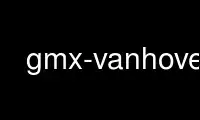
This is the command gmx-vanhove that can be run in the OnWorks free hosting provider using one of our multiple free online workstations such as Ubuntu Online, Fedora Online, Windows online emulator or MAC OS online emulator
PROGRAM:
NAME
gmx-vanhove - Compute Van Hove displacement and correlation functions
SYNOPSIS
gmx vanhove [-f [<.xtc/.trr/...>]] [-s [<.tpr/.gro/...>]] [-n [<.ndx>]]
[-om [<.xpm>]] [-or [<.xvg>]] [-ot [<.xvg>]] [-b <time>]
[-e <time>] [-dt <time>] [-[no]w] [-xvg <enum>]
[-sqrt <real>] [-fm <int>] [-rmax <real>] [-rbin <real>]
[-mmax <real>] [-nlevels <int>] [-nr <int>] [-fr <int>]
[-rt <real>] [-ft <int>]
DESCRIPTION
gmx vanhove computes the Van Hove correlation function. The Van Hove G(r,t) is the
probability that a particle that is at r_0 at time zero can be found at position r_0+r at
time t. gmx vanhove determines G not for a vector r, but for the length of r. Thus it
gives the probability that a particle moves a distance of r in time t. Jumps across the
periodic boundaries are removed. Corrections are made for scaling due to isotropic or
anisotropic pressure coupling.
With option -om the whole matrix can be written as a function of t and r or as a function
of sqrt(t) and r (option -sqrt).
With option -or the Van Hove function is plotted for one or more values of t. Option -nr
sets the number of times, option -fr the number spacing between the times. The binwidth
is set with option -rbin. The number of bins is determined automatically.
With option -ot the integral up to a certain distance (option -rt) is plotted as a
function of time.
For all frames that are read the coordinates of the selected particles are stored in
memory. Therefore the program may use a lot of memory. For options -om and -ot the
program may be slow. This is because the calculation scales as the number of frames times
-fm or -ft. Note that with the -dt option the memory usage and calculation time can be
reduced.
OPTIONS
Options to specify input files:
-f [<.xtc/.trr/...>] (traj.xtc)
Trajectory: xtc trr cpt gro g96 pdb tng
-s [<.tpr/.gro/...>] (topol.tpr)
Structure+mass(db): tpr gro g96 pdb brk ent
-n [<.ndx>] (index.ndx) (Optional)
Index file
Options to specify output files:
-om [<.xpm>] (vanhove.xpm) (Optional)
X PixMap compatible matrix file
-or [<.xvg>] (vanhove_r.xvg) (Optional)
xvgr/xmgr file
-ot [<.xvg>] (vanhove_t.xvg) (Optional)
xvgr/xmgr file
Other options:
-b <time> (0)
First frame (ps) to read from trajectory
-e <time> (0)
Last frame (ps) to read from trajectory
-dt <time> (0)
Only use frame when t MOD dt = first time (ps)
-[no]w (no)
View output .xvg, .xpm, .eps and .pdb files
-xvg <enum>
xvg plot formatting: xmgrace, xmgr, none
-sqrt <real> (0)
Use sqrt(t) on the matrix axis which binspacing # in sqrt(ps)
-fm <int> (0)
Number of frames in the matrix, 0 is plot all
-rmax <real> (2)
Maximum r in the matrix (nm)
-rbin <real> (0.01)
Binwidth in the matrix and for -or (nm)
-mmax <real> (0)
Maximum density in the matrix, 0 is calculate (1/nm)
-nlevels <int> (81)
Number of levels in the matrix
-nr <int> (1)
Number of curves for the -or output
-fr <int> (0)
Frame spacing for the -or output
-rt <real> (0)
Integration limit for the -ot output (nm)
-ft <int> (0)
Number of frames in the -ot output, 0 is plot all
Use gmx-vanhove online using onworks.net services
